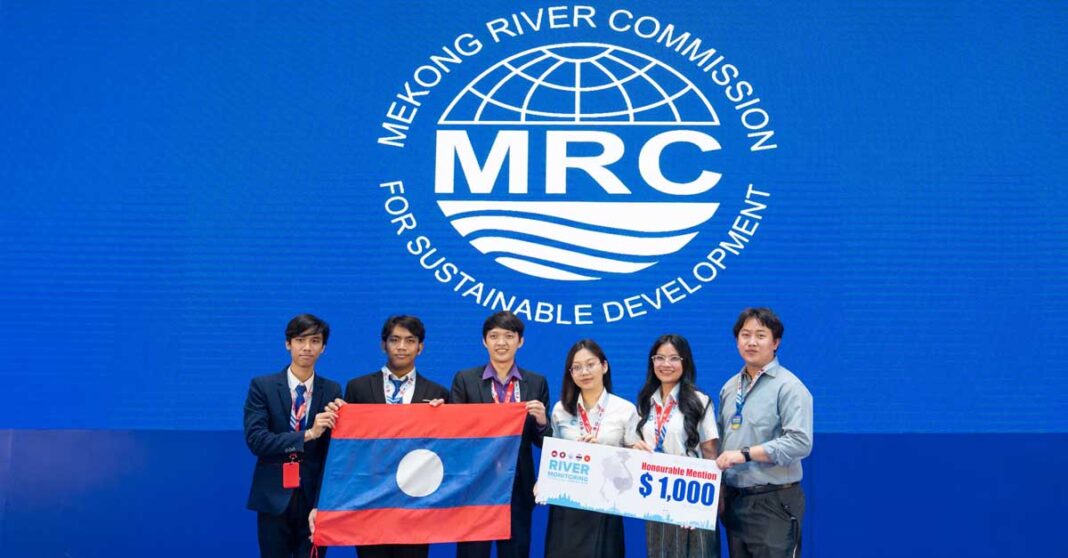The Mekong River Commission (MRC) on Monday announced the winners of its first-ever River Monitoring Technology Competition for university students. The competition was held as part of its broader effort to pursue innovative technologies that help protect Southeast Asia’s largest river – and simultaneously promote the region’s technological self-reliance.
As some say: “Mekong solutions for Mekong challenges.” To that end, the MRC recently achieved that aim through a unique event in which teams of Cambodian, Laotian, Thai, and Vietnamese students competed to develop telemetry sensor technology that can measure and monitor water level, rainfall, soil moisture, or water quality.
As one highlight of the landmark 4th MRC Summit, a panel of international judges awarded top prizes of USD 5,000 each to four separate teams: three from Cambodian universities and one from Laos. Plus, USD 1,000 to the four Honorable Mentions.
In awarding the prizes at a ceremony in Vientiane, the MRC competition organizers praised all the finalists as “role models” for their peers, as the competition’s objective was both practical and symbolic.
Santi Baran, the MRC Chief Strategy and Partnerships Officer said they were providing an invaluable contribution to Mekong society. The Mekong mainstream and its tributaries lack sufficient sensor equipment in some parts, while elsewhere, they may be relying on equipment that is pricey to maintain.
“When we first embarked on this journey, we had one equation in mind: how to reduce monitoring costs,” Baran told the audience. “If we want to stay in the business of monitoring, we have to start reinventing and embracing change. And that change comes with innovation.”
Baran then addressed the students directly: “We knew it had to be the youth that’s empowered with all the innovations in their hands that can really make a difference — if we give them an opportunity. And no one can do a better job than the youth that are here today. You showed that Mekong people can do this technology ourselves, here on Mekong soil.”
In the category of how to measure and monitor Water Level, 1st Place was awarded to the Cambodia Academy of Digital Technology, while the Thuyloi University of Vietnam earned Honorable Mention.
In the Water Quality category, the National Polytechnic Institute of Cambodia won, with an Honorable Mention to the National University of Laos while in the Rainfall category, the Institute of Technology of Cambodia received the wining, with an Honorable Mention to the Soutsaka Institute of Technology from Laos.
The Soil Moisture category was awarded to the National University of Laos, with an Honorable Mention to the Can Tho University of Vietnam.
“After joining this competition, we realized that no one else can help us if we’re not helping ourselves,” said Solita Pon, from the Cambodian Academy of Digital Technology. “This competition is a great opportunity for Mekong youths to step up and take on challenges that the Mekong River faces. It allows us to express our innovative ideas as well as our feelings – that we not only care about our River but care about our world.”
The competition originated as a way to develop cutting-edge, cost-effective, and sustainable tools as viable alternatives to river monitoring technology that the MRC already maintains along the Mekong and its tributaries. Some 250 stations track issues like hydrology, rainfall, water quality, ecological health, fisheries, and drought. Yet the equipment is often foreign-made, expensive, and challenging to maintain.
With that in mind, the MRC formally launched the competition in early October, as teams from 15 pre-selected Mekong universities were required to work under the tutelage of their professors as advisors. The most promising projects also received modest grants of USD 800 to develop their concept.
As such sensory technology is usually installed on riverbanks or in farming areas, the goal for students was to design technology suitable for its own terrain, location, weather, and functions; operable via solar power; and capable of collecting and sending telemetry data from station to server, in real-time.
The student-finalists were then brought from across the region to MRC headquarters in Vientiane, to present their projects on March 30 and 31 to a panel of neutral, foreign experts. They judged the projects according to their accuracy, durability, cost-effectiveness, and innovation.
In evaluating the projects, the judges said they were also struck by the diversity within the teams, in terms of both gender and majors. Among the 70 undergraduates were 34 women and 36 men. The 10 different sensors built were developed and tested by students from the disciplines of physics, mathematics, hydrology, chemistry, gaming, information technology, biology, environmental science, oceanography, and meteorology.
“They worked in multi-disciplinary teams and presented at the highest possible standards,” said one of the three judges, Dr. Wayne Robinson, Senior Research Fellow at Australia’s Charles Sturt University. Moreover: “The presentations were delivered in their non-native language. The judges could not have been more impressed!”



